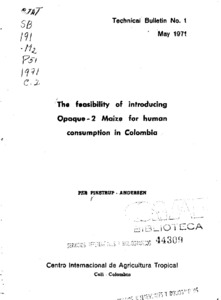The feasibility of introducing opaque-2 maize for human consumption in Colombia
The objectives of this study were to identify the major social and economic obstacles to the introduction and expansion of the production, marketing and human consumption of Opaque -2 maize in Colombia, to determine under what circumstances such an introduction and expansion might be feasible, and to suggest possible roles for science government and private enterprise in such a program. Two ways to introduce and expand the human consumption of Opaque-2 maize were considered: (1) consumption of the product by maize-buying consumers, i. e., consumption based on commercial production, and (2) consumption on the farm of home-grown Opaque-2 maize. It may be concluded that a rapid expansion of commercial production of Opaque-2 maize for direct human consumption is not feasible at the time of the study without considerable government subsidy. Promotion of Opaque-2 maize for home consumption among small farmers may be successful at low costs to the government. The obstacles to a rapid expansion of commercial production and consumption of Opaque-2 maize are primarily associated with its softness and appearance. Hence, research emphasis is needed to develop a flint type high lysine maize. Seven potentially key factors which might influence the results of efforts to introduce and expand the production and consumption of Opaque-2 maize were considered in the study. Furthermore, a number of alternative public policy measures which could be applied by the Colombian government with respect to Opaque-2 maize were outlined. Five surveys carried out among maize producers, marketing agencies and consumers furnished basic data for quantitative analyses to estimate the importance of each of the potential key factors and how they might be varied to create conditions favorable to the production and consumption of Opaque-2 maize.

